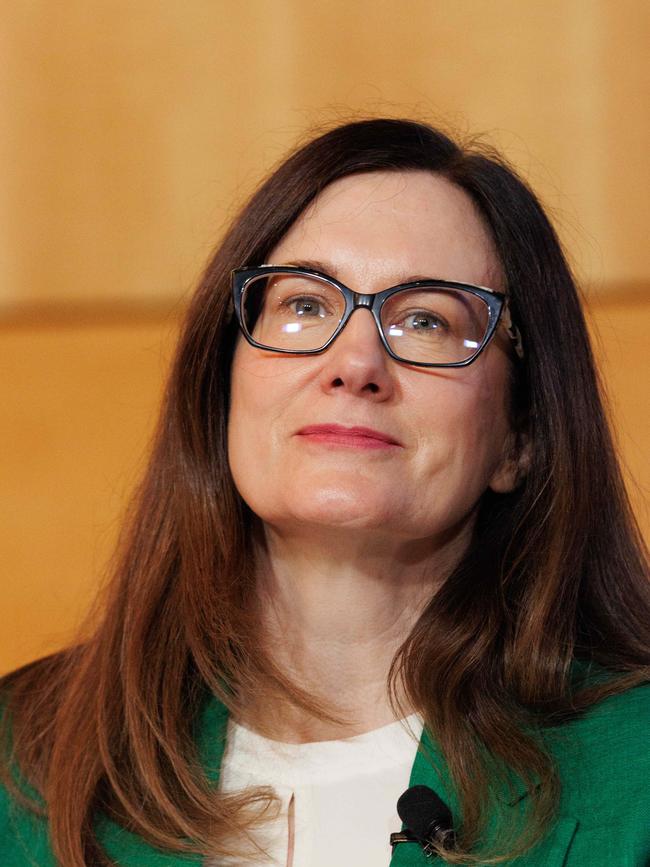ASX’s CHESS program costs blow out further
The market operator says it ‘continues to work towards’ a 2026 delivery of Release 1, with estimated project costs now expected to be at the ‘upper end’ of its range of between $105m to $125m.

Business
Don't miss out on the headlines from Business. Followed categories will be added to My News.
The market operator has not ruled out further delays on the 2026 start date for its CHESS program, as costs blow out further.
ASX Ltd said on Tuesday that it expects its CHESS Release 2 implementation to be delivered in 2029 and estimates that it will cost between $270m and $320m.
ASX “continues to work towards” a 2026 delivery of Release 1, with estimated project costs now expected to be at the “upper end of the previously communicated range of between $105m to $125m”.
It means the cost for Release 1 has blown out by up to $10m versus the midpoint of the expected range. ASX shares closed down 4.3 per cent at $66.18 after the update.
In a conference call for investors and analysts, ASX chief executive Helen Lofthouse said the revision in the cost guidance to the upper end of the previously communicated range was linked to Cloud and Data platforms.

“And probably the most material change is that’s driven the cost for the higher end of the month has really been getting more clarity around the Cloud and Data platform and the building costs for that,” she said.
“And in particular, you know, we’ve very consciously designed the configuration there for a very high resilience decision availability.”
Existing capital expenditure guidance was unchanged and includes allowances for both releases of the CHESS system, noting that expenditure for Release 2 will extend beyond the guidance period.
Capex guidance for fiscal 2025 to 2027 is for a range of $160m to $180m per year, with “an aim that capex starts to reduce after FY27”.
“As our capex is primarily to support the technology modernisation program, which includes the replacement of CHESS, inherent delivery risks in the program – including timing, scope and stakeholder dependencies – may impact this guidance,” ASX warned.
It plans to use the full $70m of the CHESS Replacement Partnership Program, subject to other considerations, with the remaining $37m to be recognised in FY26 and FY28 as significant items.
“Since I became CEO, the CHESS project and its successful delivery has been a very high priority focus. Everyone is well aware of how the delays in the previous project caused disruption and that’s something for which we have apologised, but I think the market is also aware that we’ve been working hard to progress the current CHESS project differently to minimise delays and risk while prioritising engagement and safe delivery,” Ms Lofthouse told The Australian.
“Certainly some of the investor questions today called out the cost of Release 2 as being higher than Release 1 and we’ve definitely acknowledged it’s a significant number, indeed the whole CHESS project is a significant investment and we aren’t stepping back from that. We own that. And today we reiterated the capex guidance we’ve given for FY25 and FY27 and talked about how that allows for both releases of CHESS.
“We always want to provide as much transparency as we can to investors and that’s why we’ve narrowed the language on the costs expected for Release 1 today. While what we’ve said today is at the upper end, it is within the range previously provided and we’ve talked about how we’re managing the items driving the cost.”
Citi said the capex guidance appeared to be worse than the market was expecting.
“It is no surprise to see release 2 requiring higher spend than release 1, given it has bigger implications for the broader market,” Citi analyst Nigel Pittaway said.
“However, with phase 1 also at the top end of expectations this disappointingly pushes capex towards the top end of ASX’s prior guidance range of $160m to $180m for FY25 to FY27.
This guidance excludes $10m to $12m capex for ASX’s new office fit out in each of FY25 and FY26.
“Overall, this seems to be worse than the market was expecting.”
ASX said it also continued to consult and work with the industry to consider whether to adopt a shorter T+1 settlement cycle.
“If there is to be a move to a shorter settlement cycle, ASX has received initial industry feedback that it should follow the implementation of the CHESS project,” the exchange operator said.
Mr Pittaway also warned of potential for further delays with the CHESS replacement.
“In our view, the fact that ASX is undertaking three complex IT projects at once means its prime focus is likely to remain appeasing regulators/stakeholders/technology stack rebuild and with shareholders further down the pecking order,” he said.
“Given the complex nature of these projects, we see ongoing risk these take longer and cost more than anticipated. Release 2 timings will be subject to multiple industry checkpoints and also depend on industry-wide testing alongside more user testing and dress rehearsals.”

The news comes amid rising angst about the repeated delays and cost increases that ASX has faced while attempting to replace its ageing CHESS technology system.
ASX has said it will vehemently defend a landmark legal action brought against it by the corporate regulator, denying it contravened the law or made misleading or deceptive statements relating to the bungled CHESS upgrade.
In a statement this month, the exchange operator noted it had filed a concise statement in response to the Australian Securities and Investments Commission’s Federal Court case against it.
The ASX said it denied that statements made by the company on February 10, 2022, about the status of the CHESS technology upgrade, broke the law.
ASIC kicked off the legal case against the ASX in August, alleging a “collective failure” by the company’s board and executives to keep investors, the public and stakeholders properly informed on the CHESS replacement project.
ASIC claims statements made by the exchange operator in February 2022 were “misleading and deceptive” around how its CHESS technology upgrade project was tracking.
The maximum penalty for the alleged contraventions of the ASIC Act is $555m.
More Coverage
Originally published as ASX’s CHESS program costs blow out further





